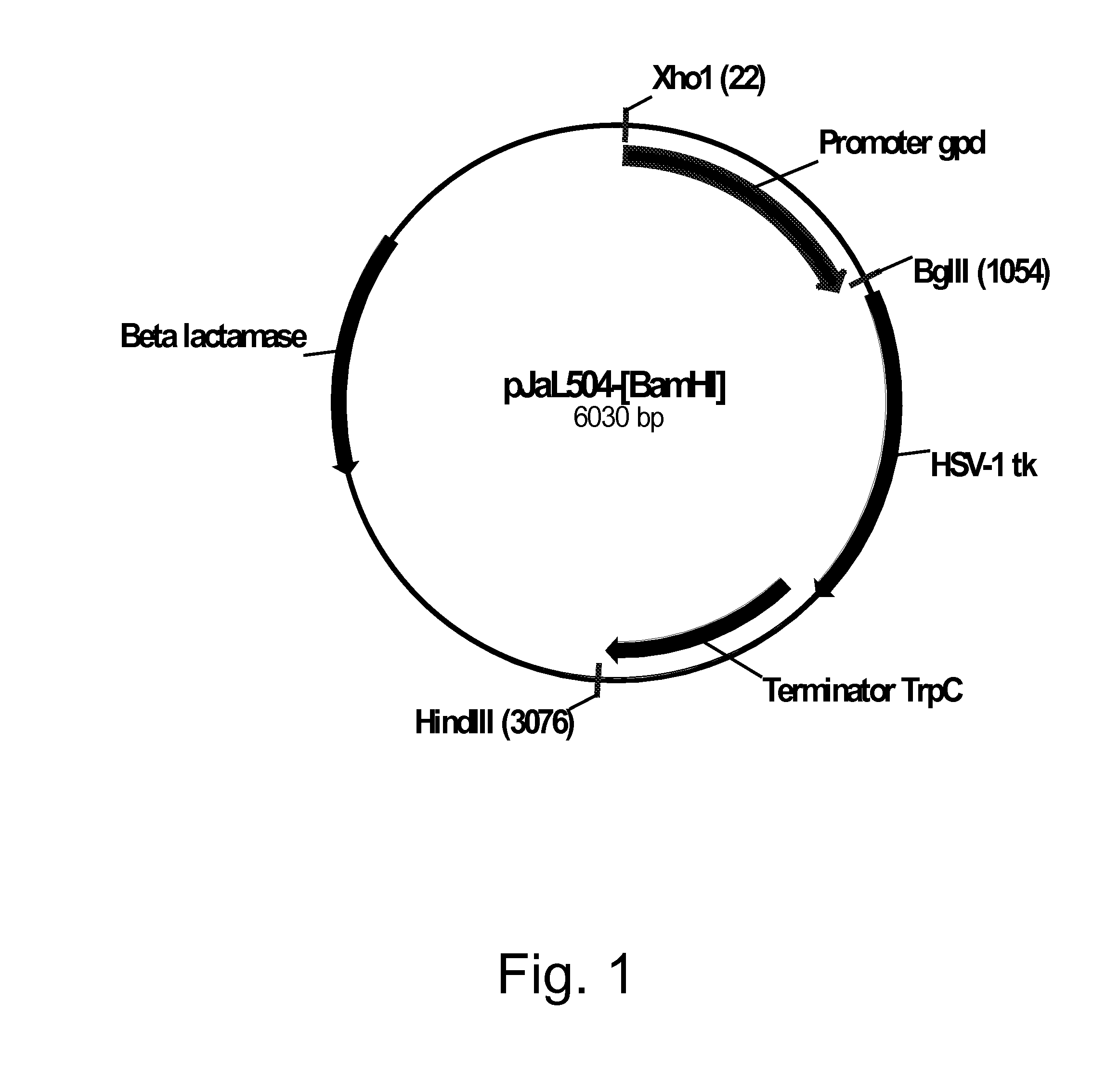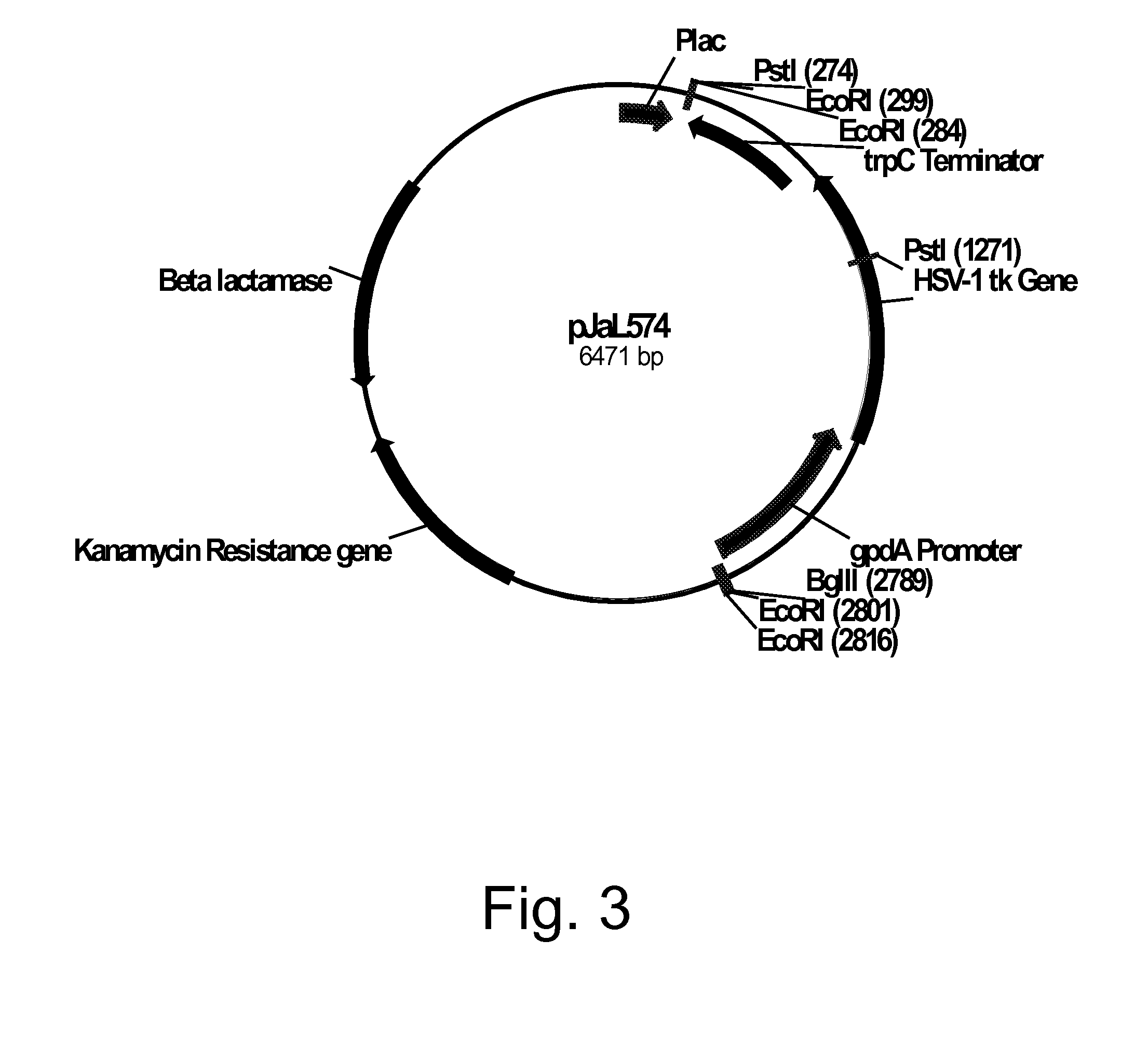Methods for using positively and negatively selectable genes in a filamentous fungal cell
a technology of selectable genes and filamentous fungal cells, which is applied in the direction of lyase, carbon-carbon lyase, enzymology, etc., can solve the problems of undesirable mutations in the host genome, toxic to cells, and system may not function in all fungi
- Summary
- Abstract
- Description
- Claims
- Application Information
AI Technical Summary
Problems solved by technology
Method used
Image
Examples
example 1
Sensitivity Testing of Fusarium venenatum WTY842-1-11 to 5-fluoro-deoxyuridine (FdU)
[0215]For a thymidine kinase gene (tk) to be useful as a negatively selectable marker, a fungus must be insensitive to rather high concentrations of the nucleoside analog 5-fluoro-deoxyuridine (FdU). In order to ascertain the degree of sensitivity of Fusarium venenatum WTY842-1-11 to FdU, a one week old culture of Fusarium venenatum WTY842-1-11 was prepared by plating a colonized agar plug of the strain taken from a 10% glycerol stock, which had been stored at −140° C., onto a VNO3RLMT plate and incubating in a ChexAll Instant Seal Sterilization Pouch (Fisher Scientific, Pittsburgh, Pa., USA) for 7 days at 26-28° C. After 7 days plugs were cut sub-marginally from the one week old culture and placed face down on VNO3RLMT medium supplemented with different concentrations of FdU (0 to 500 μM) (Sigma Chemical Co., St. Louis, Mo., USA) in 6 well plates. The plates were incubated at 26-28° C. in open ZIPLO...
example 2
Construction of Plasmid pJaL574
[0217]Plasmid pDV8 (U.S. Pat. No. 6,806,062) harbors the Herpes simplex virus type 1 thymidine kinase (HSV1-TK; tk) gene (SEQ ID NO: 37 for the DNA sequence and SEQ ID NO: 38 for the deduced amino acid sequence) as a 1.2 kb Bgl II / Bam HI fragment inserted between a 1.0 kb Xho I / Bgl II fragment of the Aspergillus nidulans glyceraldehyde-3-phosphate dehydrogenase (gpdA) promoter and a 1.8 kb Bam HI / Hind III fragment harboring the tri-functional Aspergillus nidulans indoleglycerolphosphate synthase, phosphoribosylanthranilate isomerase, and glutamine amidotransferase (trpC) transcriptional terminator. Plasmid pDV8 was digested with Bam HI, extracted with phenol-chloroform, ethanol precipitated, and then filled in using Klenow polymerase (Stratagene, La Jolla, Calif., USA). The digested plasmid was re-ligated using a QUICK LIGATION™ Kit (Roche Diagnostics Corporation, Indianapolis, Ind., USA) following the manufacturer's protocol, treated with a MINELUTE® ...
example 3
Construction of Plasmid pWTY1449-02-01
[0224]Plasmid pJaL574 was transformed into competent E. coli SCS110 cells (Stratagene, La Jolla, Calif., USA) following the manufacturer's recommended protocol. Plasmid DNA was extracted from twenty-four of the resulting transformants, using a BIOROBOT® 9600, and then subjected to analytical digestion using Eco RI and Bgl II. Subsequent DNA sequence analysis resulted in the identification of a clone with the correct sequence, which was designated pWTY1449-02-01 (FIG. 4).
PUM
| Property | Measurement | Unit |
|---|---|---|
| Fraction | aaaaa | aaaaa |
| Fraction | aaaaa | aaaaa |
| Fraction | aaaaa | aaaaa |
Abstract
Description
Claims
Application Information
 Login to View More
Login to View More - R&D
- Intellectual Property
- Life Sciences
- Materials
- Tech Scout
- Unparalleled Data Quality
- Higher Quality Content
- 60% Fewer Hallucinations
Browse by: Latest US Patents, China's latest patents, Technical Efficacy Thesaurus, Application Domain, Technology Topic, Popular Technical Reports.
© 2025 PatSnap. All rights reserved.Legal|Privacy policy|Modern Slavery Act Transparency Statement|Sitemap|About US| Contact US: help@patsnap.com



